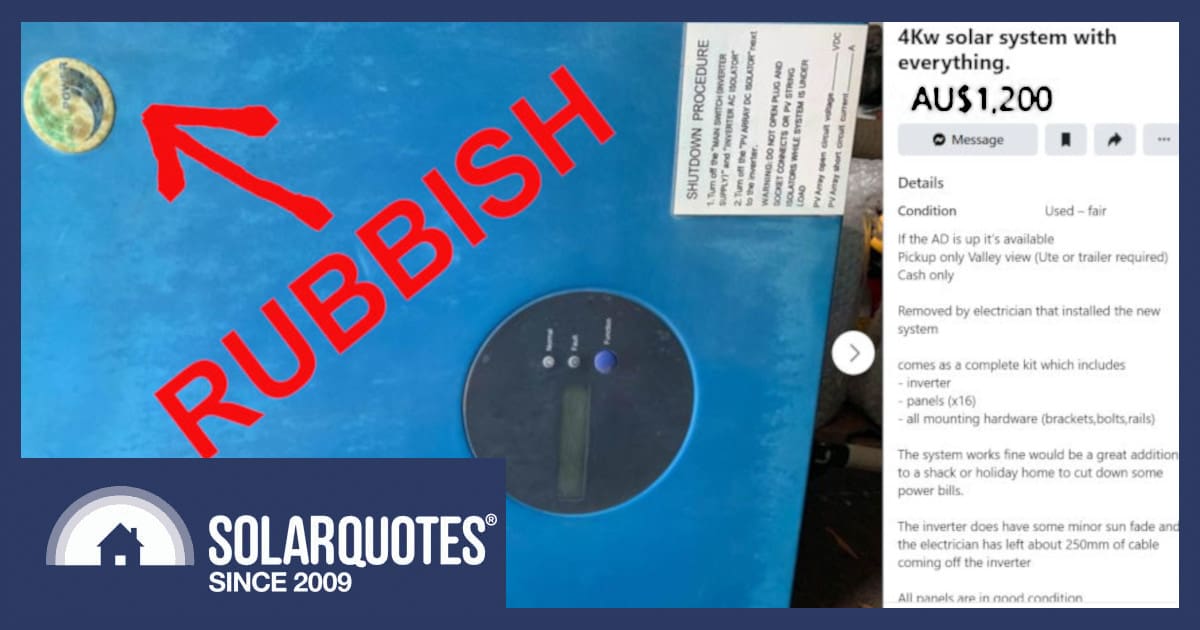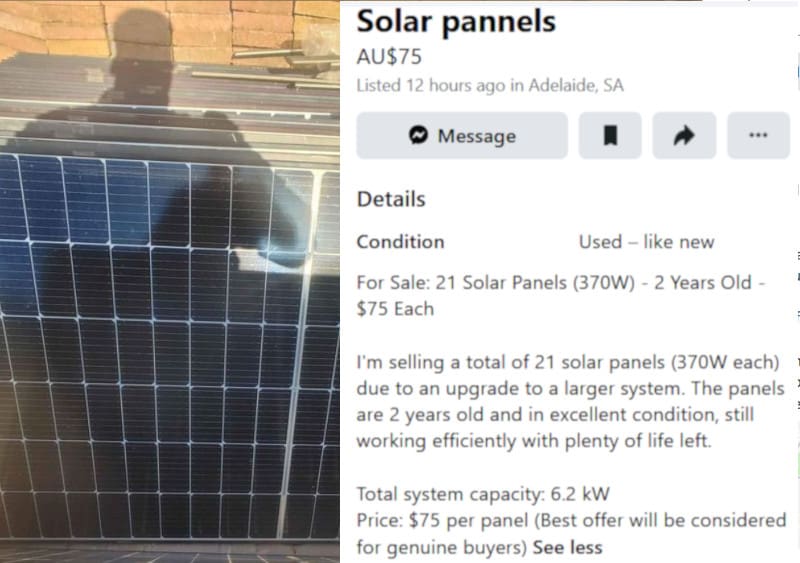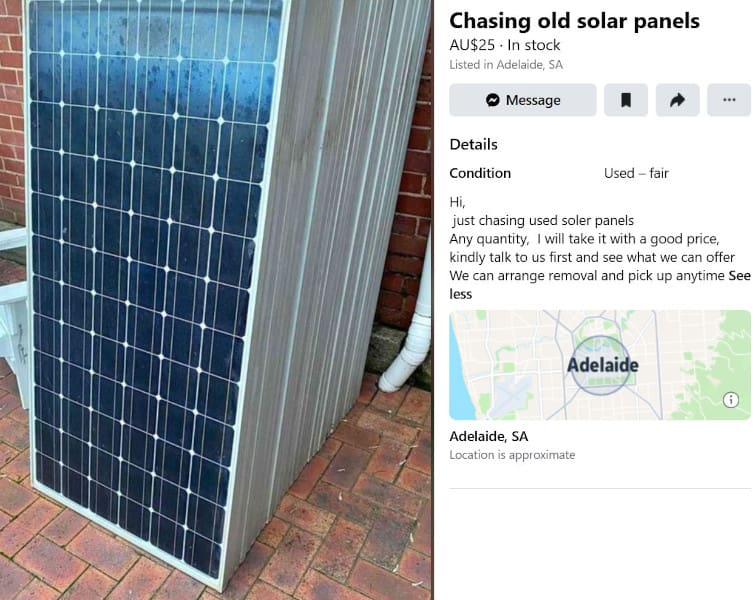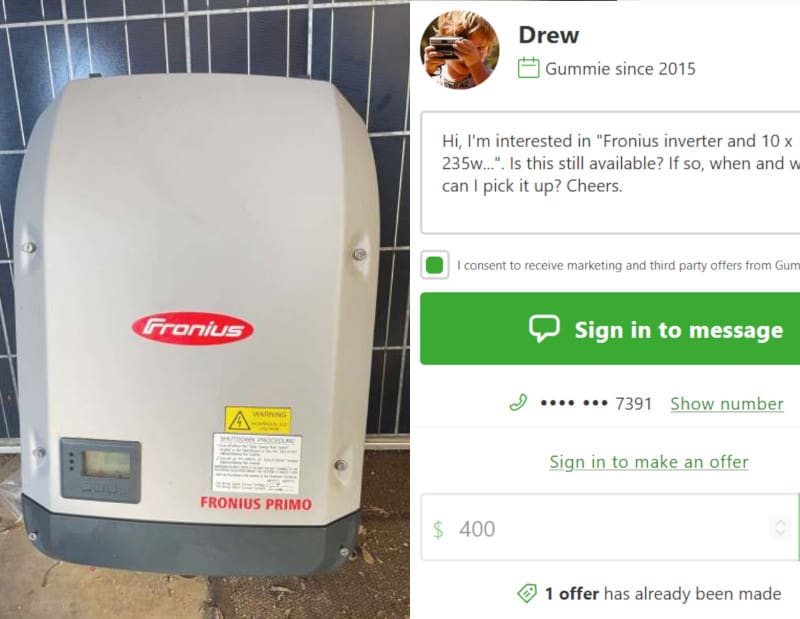
This would NOT be a good addition to your shack; in fact, Samil inverters were no good when they were new.
As solar power systems age and power prices climb, an upswing in used solar is hitting the secondhand market. But please don’t think these bargains are something you can screw to your roof and easily save a few dollars with.
Sadly, Used Solar Is Almost Worthless
The sceptics will say I’m just trying to drum up business for the solar industry, and it certainly seems a horribly wasteful thing to say, but…
- higher energy bills,
- higher electrical standards,
- updated rules,
- and falling hardware prices
…mean the systems I installed for $5/watt now retail for a tenth of that, while anything secondhand automatically costs half that value again.
Australia Labour Is Expensive
Labour in Australia is expensive, so if someone is going to scramble around on the roof, they may as well be installing new equipment with a new warranty.
As I’ve explained before, even reinstalling the solar panels you already own can be marginal.
I’ve seen solar explode over the last 16 years. It’s amazing to see the cost of new systems plummet from their heady heights to the point where you can get something like 6kW of cheap grid-connected system (badly) installed for little more than $3000.
My first system was half that size and cost four times as much, just for the panels and inverter.
Not Everything Is Worthless
If you have a power system that begs for an extra string of panels or you find some that match your existing array, you could consider adding a few modules.
Assuming you have the physical space and electrical headroom, many inverters installed with 6.6kW of panels will tolerate a couple more to get them from 133% overdrive to 150%. Just be aware technically, it’s against the rules, and you could be forced to hand back your original STC incentive payment.
However 133% is a silly Australian guideline that was somehow made a rule, and as far as rules go, the Clean Energy Regulator doesn’t audit systems beyond two years of age.

Half-cut or split cell panels only became common in the last few years. They have distinct advantages, so assuming they are a reputable brand, I would consider using them.
Off Grid Is Different
People who choose to live in the bushes find they can build a very useful solar array to charge batteries using old solar panels. Provided you use post-2013 panels with proper fire ratings and keep the system voltage below 120 volts DC (ripple free), it’s technically legal to do it yourself.
Bear in mind that any decent system to run a modern house won’t use 12V or 24V nominal equipment, though.
The same solar charge controller will handle double the energy throughput at 48v compared to 24v. The least expensive way to add DC solar is to use an MPPT regulator with a higher input voltage, which still dictates installation by a licenced trade.
It’s more common, more capable, and cheaper to use the default standard of 48V, or 120V for larger systems. The catch is that a 120V battery may need 135V during its charging cycle, which means setting it up and doing the wiring is licenced work. Not to mention the AS5139 rules for battery installations.

Thousand of old Australian solar panels end up going overseas thanks to the persistence of some active panel buyers.
Sending Old Panels Overseas
Thousands of Australian solar panels have been shipped to developing countries and onsold to charge small batteries and run solar pumps. It’s a good primary reuse of expensive technology and resources.
Some in the industry liken second-hand panel buyers to seagulls. Perhaps it’s unkind, but many are hands-on helpers who form a useful part of the new solar industry.
While trial programs are being run to learn about and establish a proper recycling protocol in Australia, it’s already well known that labour to test old panels and tag them electrically safe is expensive.
Additionally, the cost of packaging, handling, and freight quickly puts the value of used solar on par with new panels coming from the factory gate in China at 8c/watt.
Second-hand Solar Can’t Have A New Connection
Any newly connected system must adhere to the latest rules, or it won’t be granted network approval.
Not only does this include grid stability settings, but it increasingly means internet-connected inverters with remote curtailment, otherwise known as flexible exports and emergency backstop requirements.
Now, some inverters are retro compatible. We must give a big nod to Fronius here because 10 years of market-leading snap inverters will comply1 with new requirements simply by giving them a firmware update.
So the system pictured below probably isn’t bad value if you have a tame electrician to install it.

Fronius Snap inverters are well loved for a reason.
Take Home Message, Don’t Take Used Solar Home
Most solar installation work must be done by an electrician. As a licenced contractor and qualified roofer, I used to perform mechanical parts of the installation and assist the qualified electrical trades I employed. However, the requirements are more stringent now.
You need connection permission, network portal logins, certificates of compliance, and specialised tooling, so even non-solar sparkies often hand over to those who know the work best and have the training.
Don’t Try To DIY
If you bang some old junk on the roof and start ringing around for a sparky to do the final hookup, you’ll get no joy.
Those in the increasingly competitive solar industry simply aren’t interested in the reputational or licencing risk of signing off on a system that someone else installed… especially when the equipment is out of date and non-compliant.
Footnotes
- except the Fronius Galvo range; they can’t be made compliant ↩

 RSS - Posts
RSS - Posts



Still hard to know what to do when your system has become non-compliant. I have a 6 year old system with 10.8 kW of Longi Panels and a Fronius 10kW 3 phase non-hybrid inverter. The Longi panels have disappeared off the compliant list.
I’d love to get a 15kW hybrid inverter and battery system however it means I have to start from scratch.
Seems crazy to junk the panels when they are still working fine and I don’t suppose I can get STCs on new panels if the old ones are not broken….
I certainly don’t want everything ending up in landfil.
Get a SH15T and reuse the old panels and add more
Shouldn’t have to do anything. If system was compliant when installed then u don’t have to pull it down, you just can’t reinstall them in a compliant system.
The SH15T has 5 DC inputs 2ea on MPPT1+2 and 1 on MPPT 3.
Depending how your symo was strung you could put the longi’s on MPPT 1+3 and 2 big strings on MPPT2 (remembering you are no longer restricted to 600v on Residential) You can claim STC’s on the new panels and your old panels will continue to do their thing. Pair this with a SBH200 battery and you have a great system.
Hi Tim,
Your panels aren’t “non-compliant” simply because they’re not on the CEC list but they’re not eligible for STC payments if you had a pallet full of new old stock ones in the shed. So long as they’re not pre 2013 when the fire ratings changed, there’s nothing wrong with leaving them on the roof and connecting a new inverter. It’s just electrical work so you don’t technically need a solar endorsement to do it either. ie Replacing a blown inverter can be done by any electrician with some nous.
Adding another inverter with more solar becomes slightly more tricky because firstly, you’d be best served by having an inverter that meets the same string configuration. And because Fronius have much higher current ratings than many others, sometimes it’s difficult to get something as good to fill the role… unless it’s another Fronius. (Larger 3ph hybrids are coming they assure me)
The other minor issue is the Clean Energy Regulator don’t especially want old panels hooked to new inverters if you’re also connecting new panels and claiming STCs. It’s a rule I would happily ignore because it’s even more ridiculous than the 133% overdrive guideline they enforce as a rule.
However if your old unit just sits beside the new hybrid, or downstream of it on the backup circuit even, it may be able to stay put provided you meet flexible export/backstop rules.
I think you can see why I advise people to just install a big system at the outset…
Happily off grid. No choice some 40+ years ago. Been upsizing using 2nd hand 240W panels. 36 panels charge 48v 800ah house battery, 2 lovely Latronics inverters. The excessive number of 36 panels at just 5 degree tilt give amazing power (2kw?) any season, even on (thin layer) overcast days, OR foggy OR drizzily rain. During thick clouds over many days use the generator with an inverter type DC welder @ 50v plus a DIY smoothing filter keeps battery up. 36 more panels charge the EV via its 15A x 240v charger from a Queenswing brand inverter supposedly “batteryless” but it goes into fault mode at first thick cloud, but I tricked it to not needing manual reset. They lied about batteryless. Really desire to use a nicer s/h GTI for off grid to replace it but nigh on impossible??? 6x 250W panels for hot water system with thermostat controlled 48v element works a treat, and 2x12v panels for small brushless magnetically coupled header tank pump.
Have experienced the “fringe effect” of a single round cloud magnifying panel input by 15%? , and also the amazing effect of the setting sun reflecting off the underside of overhead red clouds giving power (1.2kw) downwards onto those 36 panels below, to charge the E.V. Even if you cant see the set sun, the clouds are red!!! and when no clouds= no refections= no power.
Hi I’m interested in your 48v heater element and thermostat setup. I’ve found it very difficult to find a element that has enough wattage on a DC setup, and a thermostat / relay that can handle the higher currents without burning out. Thanks.
Hi mark 48v x 1.5kw readily available. Tank is 180 litres, upgraded the insulation, temps easily 95 c, thermo mixer limits temp to shower room and kitchen to about 40c, thermostat only controls 12v to input of solid state relay can send you my circuit. Email me.
Oh… the 48v heater element has 2 loops. 4 terminals. But In series is 96 v which matches better the 90v output of 2 strings of 3 panels at 8A each = approx 16A x 90 v
Cheers Frank
Hi Mark, i replied but not sure it got there. I’ll wait and try again. If you can email me i’ll send the circuit.
Hello Frank, I too am interested in the 48V DC setup for hot water. Your circuit diagram would be greatly helpful. I have been trying to get a PV array via MPPT controller to separately heat DHW for ages and those who are willing to sell such a controller , which allows the hot water thermostat to work at 240V AC are a bit off with the fairies . (like SunFlux II, for instance). Admittedly, the SunFlux unit has the capacity to revert to grid by switching over, but your 48V setup would work similarly with a 2 element HW tank, the lower element at 48V per your design, and the upper element switched for grid topup should that be necessary. Thanks for your interest and I look fwd to your email in return.
Hi Mark & Frank,
I’ve attached some documents you were wanting to share. Remember this isn’t advice, we’re here to identify and discuss what could be dangerous for you and whoever inherits your house when you’re gone.
Hi Mark I’ll gladly oblige with circuit and info. Uploading is a too big a challenge. You have my ok to ask the website team for my email.
Hi Frank,
Send it to anthony@solarquotes.com.au
Cheers
Looking fwd to this. Cheers and thanks all
Great comment Frank! Connecting second hand solar panels to a grid connected setup is folly…..but…. using second hand panels in off grid setups is fantastic.
Some folks upgrading their grid connected systems expect an unrealistic price for their old panels, but when people are realistic they get a handy dollar for used panels, and an off grid setup can be created for very low cost.
Panels marketed for camping, caravans, or motorhomes tend to “demand” incredible (bollocks) prices….. but wise folks can make setups dirt cheap with used panels.
Used grid inverters are pretty useless for anything but ballast, or scrap aluminium for melting and casting…. but panels are great!
Thanks for your appreciation Koj, but some GTI had handy heavy toroids and heat sinks to use to make our own off grid inverters. Lots happening in Oz re this.
Experiments using GTI inverters with a small 50hz 240v external synching sources have got close to success, but from memory its the aim of GTI technology towards output current requirements, not so much the output voltage requirements, that is the undoing of those attempts, but I could be wrong. If only we could get our hands on their circuits it might get closer.
Setting the record straight above that my excessive number of 36 s/h panels often give 2 kw ON BAD DAYS as described, BECAUSE they are at 5 degrees inclination not 23, but on good days, any season, provide heaps of power even though some are up to 15 years old. Limited to 80A into 800Ah 48v battery. Location:- about 26 degrees South. Whatever… it works.
> and keep the system voltage below 50 volts DC, it’s technically legal to do it yourself.
Unless things have changed… isn’t it <120VDC and <50VAC that unlicensed people can work on..
50VDC would rule out 48V Pb-acid batteries that can charge up to near 60VDC, and 16cell LiFePO4 batteries are rarely below 50VDC
I’m glad someone is paying attention Gordon,
AS3000 clause 1.4.128 does indeed classify Extra Low Voltage as not exceeding 50VAC or 120V ripple free DC.
There’s nothing like being wrong on the internet to raise some ire, and transposing the AC & DC voltage thresholds is a great way to see the how switched on the DIY off grid crowd is.
Happily the readership here is a little less reactive than your average social media comment section, but the reason I raise it is that battery standard AS-5139 cites the more stringent IEC voltage thresholds. Increasingly we’re going to see these appear as off grid standard AS-4509 is being reviewed at the moment.
The International Electrotechnical Commission (IEC) is responsible for defining the Decisive Voltage Classification (DVC) The DVC system, as outlined in IEC 62109, categorizes voltage levels to determine safety measures for electrical protection, enclosures, and interlocks
The DVC thresholds are as follows:
DVC A
AC Voltage (RMS): ≤25V
AC Voltage (Peak): ≤35.4V
DC Voltage (Mean): ≤60V
DVC B
AC Voltage (RMS): ≤50V
AC Voltage (Peak): ≤71V
DC Voltage (Mean): ≤120V
DVC C
AC Voltage (RMS): >50V
AC Voltage (Peak): >71V
DC Voltage (Mean): >120V
Going forward I think we’ll see anything over DVC-A will become licenced work because that’s where DC earth leakage alarms are required.
Think Anthony has got the ELV ranges wrong which caused him to give incorrect advice re 48 v batteries.
As far as i know (pls correct me if wrong )
Extra low Voltage, where DIY is allowed , is 120vdc or less and 50 Vac or less .
I’m glad someone is paying attention Lyle,
AS3000 clause 1.4.128 does indeed classify Extra Low Voltage as not exceeding 50VAC or 120V ripple free DC.
There’s nothing like being wrong on the internet to raise some ire, and transposing the AC & DC voltage thresholds is a great way to see the how switched on the DIY off grid crowd is.
Happily the readership here is a little less reactive than your average social media comment section, but the reason I raise it is that battery standard AS-5139 cites the more stringent IEC voltage thresholds. Increasingly we’re going to see these appear as off grid standard AS-4509 is being reviewed at the moment.
The International Electrotechnical Commission (IEC) is responsible for defining the Decisive Voltage Classification (DVC) The DVC system, as outlined in IEC 62109, categorizes voltage levels to determine safety measures for electrical protection, enclosures, and interlocks
The DVC thresholds are as follows:
DVC A
AC Voltage (RMS): ≤25V
AC Voltage (Peak): ≤35.4V
DC Voltage (Mean): ≤60V
DVC B
AC Voltage (RMS): ≤50V
AC Voltage (Peak): ≤71V
DC Voltage (Mean): ≤120V
DVC C
AC Voltage (RMS): >50V
AC Voltage (Peak): >71V
DC Voltage (Mean): >120V
Going forward I think we’ll see anything over DVC-A will become licenced work because that’s where DC earth leakage alarms are required.
Nothing wrong with used gear. And, the regulations can and do you know what into the wind.
Used stuff can be very cost effective compared to New. Some very old used inverters can last a very very long time instance. Plus they can’t be turned off or throttled remotely.
As for home battery systems, is up to the individual. Regulations are pretty much unlawful as they are made by people who benefit from regulations as they create artificial monopolies and funny guarantee any safety or good workmanship or value for money.
Only just removed my old system.
Funnily enough the Samil inverter was the part that worked just fine.
It was the panels that were the problem and worse the they were technically still in warranty and the manufacturer still exists but they are a Chinese company with no publicly posted contact details and the original installer was long gone.
Otherwise on the rest of the article i would certainly discourage looking into second hand for any actual residential use maybe for low budget off grid but that would depend on both the actual age of the system and the condition and most likely require you to be Atleast a electrician to make that judgement.
And its not like brand new panels and inverters are unreasonably priced the real big ticket item is any batteries which you should essentially never consider secondhand. “I suppose if your qualified and intend to refurbish in the case of lead-acid you could make an exception”
Not sure if it’s some states or not. But in WA anything under 110 VDC or 50 VAC no licencing required.
So a 48V DC system with solar with a OC voltage of 100 VDC is OK
I’m glad someone is paying attention Paul,
AS3000 clause 1.4.128 does indeed classify Extra Low Voltage as not exceeding 50VAC or 120V ripple free DC.
There’s nothing like being wrong on the internet to raise some ire, and transposing the AC & DC voltage thresholds is a great way to see the how switched on the DIY off grid crowd is.
Happily the readership here is a little less reactive than your average social media comment section, but the reason I raise it is that battery standard AS-5139 cites the more stringent IEC voltage thresholds. Increasingly we’re going to see these appear as off grid standard AS-4509 is being reviewed at the moment.
The International Electrotechnical Commission (IEC) is responsible for defining the Decisive Voltage Classification (DVC) The DVC system, as outlined in IEC 62109, categorizes voltage levels to determine safety measures for electrical protection, enclosures, and interlocks
The DVC thresholds are as follows:
DVC A
AC Voltage (RMS): ≤25V
AC Voltage (Peak): ≤35.4V
DC Voltage (Mean): ≤60V
DVC B
AC Voltage (RMS): ≤50V
AC Voltage (Peak): ≤71V
DC Voltage (Mean): ≤120V
DVC C
AC Voltage (RMS): >50V
AC Voltage (Peak): >71V
DC Voltage (Mean): >120V
Going forward I think we’ll see anything over DVC-A will become licenced work because that’s where DC earth leakage alarms are required.
Being totally off grid, second hand panels are the go, I did that 4 months ago, with 24kw of solar, 84kwh of lifepo4 batteries, running 3 x 11kw inverters on 3 phase
I live in Queensland and still receive the 44 cent FIT. I recently bought and installed an AC/DC solar pool pump and second hand solar panels. I installed 7 x 250W panels in series and connected them to the DC inputs and wired the AC inputs from the grid. The pump is on a timer from 5 am to 10:30 am and so is guaranteed 5.5 hour run time per day.
I am finding that the pump runs on solar from about 6:15 am and stops at 6 pm and that on average I am using 3.8 kWh less from the grid per day. It needs to be very overcast for the pump to stop running on solar. Admittedly the pump does not run at full speed all the time that it is on solar but on a cloudless day it will.
The pool looks the best it ever has.
Hi Michael,
You’re onto something there no doubt. It’s a great use case but for many they will buy new panels for that job.
Solar pool pumps certainly are a boon for those who have the roof space.
Just out of interes, do you have a separate mains powered pump for vacuuming ?
Hi Anthony
No I have just the one pump. I have the pump limited to 2400rpm (Max is 4000) as flow rate and noise is higher than my liking.
This pump speed is fine for vacuuming. If solar is sufficient to run pump but not at 2400rpm, I turn off DC isolator and use AC.
I estimate savings at $1 per day, so payback is less than 12 months as I needed a new pump anyway.
Cheers
Thanks Michael
Great explanation.
Is there a safe / legal way to sell second hand inverters? I have a 18 month old 5kw Goodwe that came with the home I purchased this year. it was recently installed by goodwe as the seller’s old one stopped working. I’ve seen some people selling ineveters on ebay or Gumtree. Is this OK to do?
Hi Martin,
Better they’re sold to someone who can use them instead of going to scrap.
Used inverters can be installed in place of failed ones and if it’s like for like then anyone can just plug them in really.
Modifying wiring needs an electrician and strictly speaking the DNSP should be notified if the model and type have changed but in many cases they have no records to begin with so if it’s under 5kW it hardly matters.
This is my setup running 650w 48v element
Note this video says “it’s a bit makeshift”
Understatement of the year…
It has changed a lot since experiment times.
Thanks for that.
Heath Robinson would be proud..
Needs a bit more head scratching but the idea is commendable.
Happy Christmas all.